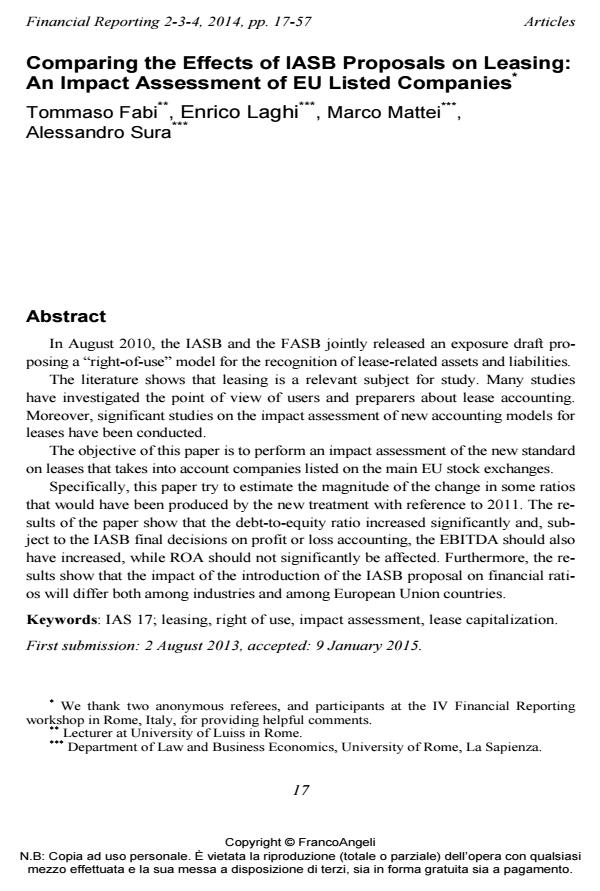Comparing the effects of IASB Proposal on leasing: an impact assessment of EU listed Companies
Journal title FINANCIAL REPORTING
Author/s Tommaso Fabi, Enrico Laghi, Marco Mattei, Alessandro Sura
Publishing Year 2015 Issue 2014/2-3-4
Language English Pages 41 P. 17-57 File size 411 KB
DOI 10.3280/FR2014-002002
DOI is like a bar code for intellectual property: to have more infomation
click here
Below, you can see the article first page
If you want to buy this article in PDF format, you can do it, following the instructions to buy download credits

FrancoAngeli is member of Publishers International Linking Association, Inc (PILA), a not-for-profit association which run the CrossRef service enabling links to and from online scholarly content.
In August 2010, the IASB and the FASB jointly released an exposure draft proposing a "right-of-use" model for the recognition of lease-related assets and liabilities. The literature shows that leasing is a relevant subject for study. Many studies have investigated the point of view of users and preparers about lease accounting. Moreover, significant studies on the impact assessment of new accounting models for leases have been conducted. The objective of this paper is to perform an impact assessment of the new standard on leases that takes into account companies listed on the main EU stock exchanges. Specifically, this paper try to estimate the magnitude of the change in some ratios that would have been produced by the new treatment with reference to 2011. The results of the paper show that the debt-to-equity ratio increased significantly and, subject to the IASB final decisions on profit or loss accounting, the EBITDA should also have increased, while ROA should not significantly be affected. Furthermore, the results show that the impact of the introduction of the IASB proposal on financial ratios will differ both among industries and among European Union countries.
Keywords: IAS 17; leasing, right of use, impact assessment, lease capitalization
- Capitalisation of operating lease and its impact on firm’s financial ratios: Evidence from Italian listed companies Roberto Maglio, Valerio Rapone, Andrea Rey, in Corporate Ownership and Control /2018 pp.152
DOI: 10.22495/cocv15i3c1p1
Tommaso Fabi, Enrico Laghi, Marco Mattei, Alessandro Sura, Comparing the effects of IASB Proposal on leasing: an impact assessment of EU listed Companies in "FINANCIAL REPORTING" 2-3-4/2014, pp 17-57, DOI: 10.3280/FR2014-002002